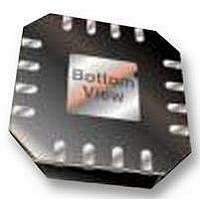ADP2107ACPZ-1.8 Analog Devices Inc, ADP2107ACPZ-1.8 Datasheet - Page 24

ADP2107ACPZ-1.8
Manufacturer Part Number
ADP2107ACPZ-1.8
Description
V REG, 2A 1.8V, SMD, LFCSP-16, 2107
Manufacturer
Analog Devices Inc
Datasheet
1.ADP2105ACPZ-1.8-R7.pdf
(36 pages)
Specifications of ADP2107ACPZ-1.8
Primary Input Voltage
3.6V
No. Of Outputs
1
Output Voltage
1.8V
Output Current
2A
Voltage Regulator Case Style
LFCSP
No. Of Pins
16
Operating Temperature Range
-40°C To +125°C
Svhc
No SVHC
Lead Free Status / RoHS Status
Lead free / RoHS Compliant
ADP2105/ADP2106/ADP2107
DESIGN EXAMPLE
Consider an application with the following specifications:
Input Voltage = 3.6 V to 4.2 V.
Output Voltage = 2 V.
Typical Output Current = 600 mA.
Maximum Output Current = 1.2 A.
Soft Start Time = 2 ms.
Overshoot ≤ 100 mV under all load transient conditio
1.
2.
3.
Choose the dc-to-dc converter that satisfies the maximum
output current requirement. Because the maximum o
current for this application is 1.2 A, the ADP2106 with
maximum output current of 1.5 A is ideal for this
application.
See whether the output voltage desired is available as a
fixed output voltage option. Because 2 V is not one of the
fixed output voltage options available, choose the adjustable
version of ADP2106.
The first step in external component selection for an
adjustable version converter is to calculate the resistance of
the resistive voltage divider that sets the output voltage.
Calculate the minimum inductor value as follows:
For the ADP2106:
L > (0.83 μH/V) × V
Ne
inductor peak-to-peak current ripple (ΔI
maximum load current at the maximum input voltage as
follows:
⇒
⇒
R
R
L
2
TOP
IDEAL
5 .
BOT
xt, calculate the ideal inductor value that sets the
L > 0.83 μH/V × 2 V
L > 1.66 μH
×
4
2
=
=
2 .
×
=
R
×
I
4 (
2
STRING
V
BOT
1
5 .
2 .
2 .
FB
×
⎡
⎢
⎣
−
V
V
V
) 2
IN
OUT
=
OUT
×
μH
V
20
0
I
8 .
FB
×
−
OUT
LOAD
μA
=
(
V
V
V
2.18
FB
IN
( MAX
=
⎤
⎥
⎦
−
40
=
μH
V
)
40
kΩ
OUT
kΩ
)
μH
×
⎡
⎢
⎢
⎣
=
2
L
V
) to 1/3 of the
0
−
8 .
0
V
8 .
ns.
V
⎤
⎥
⎥
⎦
utput
a
=
60
Rev. C | Page 24 of 36
kΩ
4.
5.
6.
7.
8.
9.
0
The closest standard inductor value is 2.2 μH. The maximum
rms cu rent of the inductor is to be greater than 1.2 A, and
the saturation current of the inductor is to be greater than
2 A. One inductor that meets these criter
2.2 μH from Coilcraft.
Choose the output capacitor based on the transient response
requirements. The worst-case load transient is 1.2 A, for
which the overshoot must be less than 100 mV, which is 5%
of the output voltage. For a 1 A lo
must be less than 4% of the output voltage, then from
Figure 39:
Output Capacitor × Output Voltage = 60 μC
Taking into account the loss of capacitance due to dc bias, as
shown in Figure 40, two 22 μF X5R MLCC capacitors from
Murata (GRM21BR60J226M) are sufficient for this
application.
Because the ADP2106 is being used in this application, the
input capacitors are 10 μF and 4.7 μF X5R Murata capacitors
(GRM21BR61A106K and GRM21BR61A475K).
The input filter consists of a small 0.1 μF ceramic capacitor
placed between IN and AGND and a 10 Ω resistor placed
between IN and PWIN1.
Choose a soft start capacitor of 2 nF to achieve a soft start
time of 2 ms.
Calculate the compensation resistor and capacitor as
follows:
C
⇒
8 .
COMP
⎛
⎜
⎜
⎝
Output
50
r
R
=
μA
COMP
π
2 (
F
/
Capacitor
CROSS
) π
V
=
×
×
0
2
80
. 2
R
8 .
8125
COMP
⎛
⎜
⎜
⎝
kHz
2 (
=
G
) π
A
2
60
=
m
F
0 .
G
/
CROSS
π
μC
V
CS
V
×
⎞
⎟
⎟
⎠
80
⎛
⎜
⎜
⎝
≈
ad transient, the overshoot
⎞
⎟
⎟
⎠
30
kHz
⎛
⎜
⎜
⎝
30
C
μF
0
2
OUT
μF
8 .
V
×
×
V
REF
215
V
2
ia is the LPS4012-
OUT
V
kΩ
⎞
⎟
⎟
⎠
⎞
⎟
⎟
⎠
=
=
=
215
39
kΩ
pF












